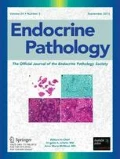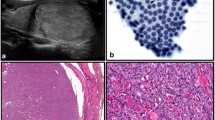Abstract
Noninvasive follicular thyroid neoplasm with papillary-like nuclear features (NIFTP) was recently proposed as a designation for a subset of follicular variant papillary thyroid carcinoma (FVPTC). Encapsulated FVPTC has been shown to be a fairly indolent tumor, and NIFTP are expected to represent the most indolent subset of these tumors. Many of the exclusion criteria for NIFTP related to architecture and a lack of psammoma bodies are designed to preclude the inclusion of more aggressive non-FVPTC tumors in this indolent group and also exclude the diagnosis of FVPTC. In addition to strict application of histologic features to ensure that NIFTP represents a subset of encapsulated FVPTC without invasion, other exclusion criteria including high mitotic activity and necrosis may also lead to a lack of one-to-one correlation between the diagnosis of NIFTP and encapsulated FVPTC without invasion. In this series, 50 cases previously diagnosed as FVPTC over a 2-year period from a large academic center are retrospectively reviewed for reclassification as NIFTP. Additionally, cases not meeting criteria for NIFTP are more accurately classified using the most up to date WHO criteria. Prior BRAF V600E mutation testing was examined for these tumors when available. Seventeen of 50 (34%) tumors met criteria for classification as NIFTP and, 17 (34%) were classified as encapsulated FVPTC with invasion. Strict application of architectural features led to classification of 12 (24%) tumors as non-FVPTC with a variety of more aggressive designations. Tumors classified as NIFTP and encapsulated FVPTC with invasion lacked lymph node metastases (0/4; 0/7, respectively) and BRAF mutations (0/12; 0/13, respectively). In contrast, infiltrative FVPTC, encapsulated PTC with or without invasion, and conventional PTC showed more aggressive features with lymph node metastases and BRAF V600E mutations. One case not meeting criteria for NIFTP maintained the diagnosis of encapsulated FVPTC without invasion but demonstrated significant mitotic activity (three mitoses/ten HPF) and lacked lymph node metastases and BRAF V600E mutation. These findings demonstrate the importance of using strict criteria, especially the lack of true papillary architecture, for the diagnosis of NIFTP and encapsulated FVPTC to ensure that only truly indolent tumors will be included in these diagnoses and to allow tumors with potential for more aggressive behavior to be appropriately treated.



Similar content being viewed by others
Change history
19 June 2018
In the original publication, the author name Kimberly Point du Jour was incorrectly captured. The correct Given name should be Kimberly and the Family name should be Point du Jour. The correct author name is presented in this correction article.
References
Lim H, Devesa SS, Sosa JA, Check D, Kitahara CM Trends in Thyroid Cancer Incidence and Mortality in the United States, 1974–2013. JAMA : the Journal of the American Medical Association 317: 1338–1348, 2017.
Noone AM, Cronin KA, Altekruse SF et al. Cancer Incidence and Survival Trends by Subtype Using Data from the Surveillance Epidemiology and End Results Program, 1992–2013. Cancer Epidemiology, biomarkers & prevention : a publication of the American Association for Cancer Research, cosponsored by the American Society of Preventive Oncology 26: 632–641, 2017.
Davies L, Welch HG Increasing incidence of thyroid cancer in the United States, 1973–2002. JAMA : the Journal of the American Medical Association 295: 2164–2167, 2006.
Chen KT, Rosai J Follicular variant of thyroid papillary carcinoma: a clinicopathologic study of six cases. The American journal of surgical pathology 1: 123–130, 1977.
Cancer Genome Atlas Research N Integrated genomic characterization of papillary thyroid carcinoma. Cell 159: 676–690, 2014.
Lee SR, Jung CK, Kim TE et al. Molecular genotyping of follicular variant of papillary thyroid carcinoma correlates with diagnostic category of fine-needle aspiration cytology: values of RAS mutation testing. Thyroid : official journal of the American Thyroid Association 23: 1416–1422, 2013.
Baloch ZW, Shafique K, Flannagan M, Livolsi VA Encapsulated classic and follicular variants of papillary thyroid carcinoma: comparative clinicopathologic study. Endocr Pract 16: 952–959, 2010.
Thompson LD Ninety-four cases of encapsulated follicular variant of papillary thyroid carcinoma: A name change to Noninvasive Follicular Thyroid Neoplasm with Papillary-like Nuclear Features would help prevent overtreatment. Modern pathology : an official journal of the United States and Canadian Academy of Pathology, Inc 29: 698–707, 2016.
Nikiforov YE, Seethala RR, Tallini G et al. Nomenclature Revision for Encapsulated Follicular Variant of Papillary Thyroid Carcinoma: A Paradigm Shift to Reduce Overtreatment of Indolent Tumors. JAMA Oncol 2: 1023–1029, 2016.
Piana S, Frasoldati A, Di Felice E, Gardini G, Tallini G, Rosai J Encapsulated well-differentiated follicular-patterned thyroid carcinomas do not play a significant role in the fatality rates from thyroid carcinoma. Am J Surg Pathol 34: 868–872, 2010.
Liu J, Singh B, Tallini G et al. Follicular variant of papillary thyroid carcinoma: a clinicopathologic study of a problematic entity. Cancer 107: 1255–1264, 2006.
Ghossein R Encapsulated malignant follicular cell-derived thyroid tumors. Endocrine pathology 21: 212–218, 2010.
Williams ED Guest Editorial: Two Proposals Regarding the Terminology of Thyroid Tumors. International journal of surgical pathology 8: 181–183, 2000.
Lloyd RV, Osamura RY, Kloppel G, Rosai J: WHO Classification of Tumours of Endocrine Organs, Lyon, France: IARC, 2017.
Richman SD, Seymour MT, Chambers P et al. KRAS and BRAF mutations in advanced colorectal cancer are associated with poor prognosis but do not preclude benefit from oxaliplatin or irinotecan: results from the MRC FOCUS trial. J Clin Oncol 27: 5931–5937, 2009.
Rivera M, Tuttle RM, Patel S, Shaha A, Shah JP, Ghossein RA Encapsulated papillary thyroid carcinoma: a clinico-pathologic study of 106 cases with emphasis on its morphologic subtypes (histologic growth pattern). Thyroid : official journal of the American Thyroid Association 19: 119–127, 2009.
Bizzarro T, Martini M, Capodimonti S et al. Young investigator challenge: The morphologic analysis of noninvasive follicular thyroid neoplasm with papillary-like nuclear features on liquid-based cytology: Some insights into their identification. Cancer 124: 699–710, 2016.
Vivero M, Kraft S, Barletta JA Risk stratification of follicular variant of papillary thyroid carcinoma. Thyroid : official journal of the American Thyroid Association 23: 273–279, 2013.
Cho U, Mete O, Kim MH, Bae JS, Jung CK Molecular correlates and rate of lymph node metastasis of non-invasive follicular thyroid neoplasm with papillary-like nuclear features and invasive follicular variant papillary thyroid carcinoma: the impact of rigid criteria to distinguish non-invasive follicular thyroid neoplasm with papillary-like nuclear features. Modern pathology : an official journal of the United States and Canadian Academy of Pathology, Inc 30: 810–825, 2017.
Jiang XS, Harrison GP, Datto MB Young Investigator Challenge: Molecular testing in noninvasive follicular thyroid neoplasm with papillary-like nuclear features. Cancer 124: 893–900, 2016.
Ohori NP, Seethala RR, Nikiforov YE Young Investigator Challenge: Molecular testing in noninvasive follicular thyroid neoplasm with papillary-like nuclear features. Cancer 125: 292–293, 2017.
Jiang XS, Harrison GP, Datto MB Reply to Young Investigator Challenge: Molecular testing in noninvasive follicular thyroid neoplasm with papillary-like nuclear features. Cancer 125: 293–294, 2017.
Wong KS, Strickland KC, Angell TE et al. The Flip Side of NIFTP: an Increase in Rates of Unfavorable Histologic Parameters in the Remainder of Papillary Thyroid Carcinomas. Endocrine pathology 28: 171–176, 2017.
Lloyd RV, Erickson LA, Casey MB et al. Observer variation in the diagnosis of follicular variant of papillary thyroid carcinoma. The American journal of surgical pathology 28: 1336–1340, 2004.
Rivera M, Ricarte-Filho J, Patel Set al. Encapsulated thyroid tumors of follicular cell origin with high grade features (high mitotic rate/tumor necrosis): a clinicopathologic and molecular study. Hum Pathol 41: 172–180, 2010.
Author information
Authors and Affiliations
Corresponding author
Ethics declarations
Conflict of Interest
The authors declare that they have no conflict of interest.
Rights and permissions
About this article
Cite this article
du Jour, K.P., Schmitt, A.C., Chen, A.Y. et al. Application of Strict Criteria for Noninvasive Follicular Thyroid Neoplasm with Papillary-Like Nuclear Features and Encapsulated Follicular Variant Papillary Thyroid Carcinoma: a Retrospective Study of 50 Tumors Previously Diagnosed as Follicular Variant PTC. Endocr Pathol 29, 35–42 (2018). https://doi.org/10.1007/s12022-017-9509-0
Published:
Issue Date:
DOI: https://doi.org/10.1007/s12022-017-9509-0




